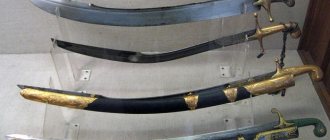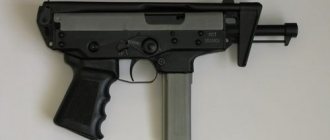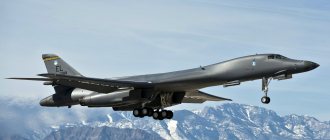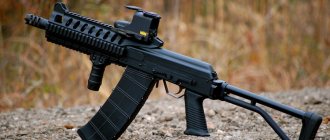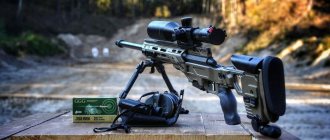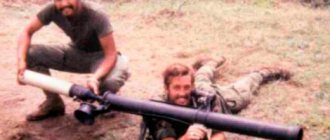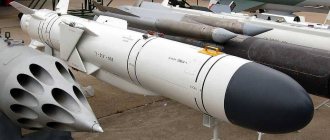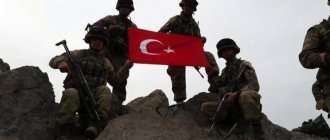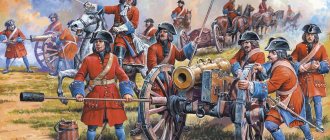Each nation has its own national characteristics and traditions. Weapons play an important role in self-identification. Most of the population, when asked about the weapons of the Turks, will answer “a crooked saber, a scimitar.” It is difficult to blame anyone for illiteracy, since the scimitar is one of the first attempts by the Turkish army to bring edged weapons onto the battlefield into a unified system.
In the army of the Ottoman Empire, much attention was paid to the individual fighting qualities of each soldier, especially from the elite Janissary corps. They needed the best weapons to win.
History of origin
Few weapons can boast of a legend associated with their origin. The scimitar, according to Turkish stories, appeared after one of the Turkish rulers forbade the Janissaries to carry weapons; the warriors cleverly circumvented the ban. The guardsmen ordered to forge knives the size of their hands, and this is how scimitars turned out.
In fact, the appearance of the scimitar was somewhat more complicated. With the increasing complexity of warfare and the improvement of weapons, the Turkish infantry needed a new type of sword.
The weapon should be able to stab and cut the enemy with equal efficiency. The sword khopesh, known since the times of Ancient Egypt, is taken as the basis. The bend of the blade gave an advantage in chopping, and the sharpened edge made it possible to stab the enemy.
But there was a significant difference: the blade was made with the same width along its entire length. A few specimens had a thickening at the end of the blade.
As the Ottoman army transformed from heavy cavalry to infantry, the fighters needed new, effective close-combat weapons.
The Turks used daggers both against regular armies and against rebel peasants dissatisfied with the oppression of the Sublime Porte. Heavy weapons were ineffective in the fight against partisans, and the Janissary Corps began mass procurement of a new type of blade.
The new weapon turned out to be successful. Many Ottoman allies adopted it, and already in the 18th century it was in service with the Balkan peoples, Caucasians, as well as the Crimean Tatars.
Falchion
The curved swords of this series are also called falchion from the English word falchion. The weapon is a European single-blade element, flared to one end with a similar sharpening.
Another name for this bladed weapon is lansknetta. The main purpose was to deliver serious chopping blows, for which purpose the noses of these devices were often made rounded. These knives were used mainly by English archers, cavalry and sailors. Two-handed falchions did not have a military purpose; they more often served as a weapon for executioners.
How and from what were scimitars made?
Scimitars had a curved blade, but in such a way that the tip and handle were on the same line. They tried to make the center of gravity closer to the handle, which ensured a comfortable and therefore reliable grip. The single-sided blade caused both cut and puncture wounds.
With a slashing blow, damage was inflicted by the upper part of the blade, cutting wounds were inflicted by the lower part of the blade.
The blade itself weighed a little, up to a kilogram, which was a plus and a minus. The positive thing was that an experienced fighter hardly felt the weight and could hack for a long time; the negative factor was that he was powerless in front of heavy armor.
A special feature of the scimitar was the absence of a guard. Scimitars were worn in the belt on the stomach, so that the warrior could equally effectively use the weapon with both his right and left hands. Despite the obvious advantages of the guard, it caught clothes and made it difficult to quickly prepare for battle.
For more effective use, the handle had so-called “ears”.
They served to counteract the centrifugal force that tends to tear the dagger out of the fighter’s hands during a quick cut.
The metal used for these weapons varied greatly. It could be steel from Damascus, damask metal and local types of material. Much depended on the customer’s material resources. The handle was made of wood, bone, and precious metals. The scabbard was of particular importance.
They were created using wood and metal, covered with leather, often embossed or with precious stones. The sheath weighed up to half the dagger itself. This made it possible not to sheathe a bloody scimitar; although cleaning was not carried out automatically, some of the dirt was washed off from the blade.
There are several types of scimitars, different in both shape and decoration, namely:
- the Istanbul type, the most widespread and diverse due to the thousands of masters who lived in the capital of the empire;
- Balkan type, characterized by the angularity of the “ears” and the large use of copper in decoration;
- Asian Minor type, with a variety of blades, long blades and an abundance of horn in the decoration of the handle;
- scimitars of Eastern Anatolia, with small “ears” and an almost straight blade.
The Turkish army, known for its diversity and custom-made weapons, was replete with various types of scimitars. Later, however, many ended up in Europe as trophies, striking with the richness of their decoration and unusual shapes.
The crooked sword of the peoples of the East
These devices found their use back in the Middle Ages, differing only in names and configuration. One of the first representatives of such types of bladed weapons is khopesh. This development was further reflected in blades such as kopis and falcat.
Curved swords of the kopis type have a one-sided sharpening and are oriented towards chopping blows. The length of the blades ranges from 530 to 700 millimeters. If the back of the weapon is sharpened on one side, it resembles a standard variation of a machete.
In Greece, curved kopis swords were used to a limited extent. This follows from rare mentions and displays of weapons on vases, drawings and other images. Presumably, it was this blade that became the prototype of European analogues, which were brought by merchants and mercenaries in the fifth century BC.
Use on the battlefield
Scimitars were used in all wars of the vast Ottoman Empire from its birth in the 16th century until the 20th century. The Janissary infantry, the backbone of the Turkish army, often used scimitars in addition to firearms.
In Turkey, individual training of fighters was given great importance. Unlike most European infantry, recruited from the peasantry and townspeople, the Janissaries were a caste, and their training in the use of blades began in childhood.
Ottoman opponents often gained the upper hand thanks to the formation and cohesion of the combat units, but in one-on-one combat the Janissaries had no equal.
It is not without reason that until the Battle of Vienna in 1683, the Turkish threat frightened all of Europe.
Janissaries usually had two blades. They held the curved saber in their right hand with a straight grip. The scimitar is in the left, reversed, so that its blade is behind the back. Attacking, the warriors showered the enemy with a hail of blows, each of which could be fatal.
The reverse grip of the scimitar, at first glance inconvenient, made it possible to deliver cutting blows from the bottom up. Someone carried only a scimitar, taking a small convex shield in the other hand.
In addition to the Janissaries, the blade was often used by hired killers. The Assassin's scimitar was not fundamentally different from conventional weapons. However, the effectiveness of the weapon terrified the victims' guards.
Europeans treated the scimitar as an ignoble weapon, considering its lightness to be frivolous for a real weapon. The Turks, however, did not care much about this and they continued to use daggers in all wars and skirmishes.
The convenient, although lightweight, weapon found wide popularity among peoples directly associated with the Turks.
The scimitar was respected and often used by Serbian and Montenegrin independence fighters.
The Zaporozhye Cossacks, both in the service of the Sublime Porte and opponents of the Turks, often used this type of dagger. They gladly took it as a trophy. Custom-made examples for officers and nobles were decorated with precious stones, bone, silver or gold.
Dao (shoudao)
The curved sword among the peoples of the Chinese provinces is usually called dao. This hieroglyph is applicable to almost all analogues, regardless of origin. This list includes all specimens with one-sided sharpening.
These include:
- Curved combat knives.
- Sabers.
- Japanese swords.
- Halberds.
The curved sword of a samurai, known to the general public as a katana or tao, was referred to as tao until the 15th century. This weapon is one of the oldest in China. The end of the blade was sharpened as much as possible, the handle was made of hard wood, the length depended on the type of sword. It is worth noting that dao, the most popular type of bladed weapon in question in world history, was used by both ordinary soldiers and generals.
How the scimitar lost its meaning
The decline of the scimitars came simultaneously with the end of the Janissary corps. This dagger was not only a weapon for the Sultan’s guards, but also a symbol of freedom and strength. With the dissolution and physical elimination of the elite detachment, the scimitar actually lost its status. Of course, they did not stop using the product.
Detachments of bashi-bazouks, irregular infantry composed of fanatics, and more often of bandits, used these weapons until they ceased to exist at the end of the 19th century. Actually, the Turks themselves were afraid of bashi-bazouks, the translation of this term is “crazy-headed, reckless head.”
On the battlefields of the First World War, Turkish soldiers also used scimitars. Excavations at the sites of the Battle of Galippoly provide evidence of this. A tragic page in the chronicle of the Armenian people is also connected with scimitars.
During the genocide, Turkish soldiers used scimitars against civilians.
Unexpectedly, the scimitar came in handy in the French army. A number of rifles, for example Chasso, which proved themselves during the Franco-Prussian War, received scimitar bayonets. The slightly smaller blade made it possible for soldiers to fearlessly clean a gun with an attached bayonet.
Peculiarities
The development of industry and the skill of blacksmiths made it possible to make the blade much narrower with the possibility of equipping it with elmanya (thickening of the blade near the tip). This option was much more difficult to forge than a flat blade. At the same time, the uniform size made it possible to conveniently and quickly hide the weapon in its sheath.
The short curved Janissary sword, like many other analogues, was first worn without a sheath or sheath, simply in the belt (following the example of an ax). It was impossible to transport something made of Damascus steel in this way, so similar swords began to be placed on silk ribbons. One edge was attached to the handle, and the second was passed through a special ring-shaped eye. Carrying a sharp sword in this way was inconvenient and dangerous.
Scimitar in art
World literature is replete with references to this type of weapon. The authors consider the description of a man who was in the East to be completed with the cherry on the cake - a scimitar on a Persian carpet on the wall.
This description is equally true for both domestic and foreign literature. There are also negative assessments in prose. Thus, in Tolkien’s “The Lord of the Rings” trilogy, the orcs are all armed with scimitars.
However, Jackson’s film version smoothed out this idea of the Janissaries’ weapons. Apparently, the director considered the scimitar not so sinister and replaced it with more cranberry blades.
Despite its celebrity, and even a certain cult following, a real scimitar is rarely seen in feature films. The hero of the article is replaced with different types of sabers, tulvars and even swords, shamelessly passing them off as Janissary weapons.
With the exception of historical films, where specialists take the issue seriously, or Turkish films, the scimitar is rarely seen on the big screen.
Scimitars that belonged to famous warriors and commanders can be seen in many museums around the world. In Russia, in the Golden Gate Museum in Vladimir, there is a scimitar of an unknown warrior, which has an extension at the end of the blade.
A rare copy open for public viewing. The very distribution speaks of the popularity of this type of dagger in the world. For historians and people interested in weapons, the scimitar will forever remain the faithful companion of the Janissary, the best warrior of the Islamic world and the thunder of Europe.
Steel eggs
Ottoman swords, both in Turkey itself and abroad (mainly in Russia), are known under the name “Damascus”. They were made from high-quality Syrian steel and using special technologies. Gunsmiths who worked on Damascus steel were given the title "Dimishkchi". Among them there was a tradition of giving the sultans steel blanks for Damascus swords, which were called “eggs.” It is very symbolic that quite birds of prey “hatched” from such steel eggs. It is known that a certain master named Hussein gave Sultan Suleiman Kanuni one steel egg in the first years of his reign, and master Murad - 10 eggs.
There is information that during the reign of Fatih Sultan Mehmed, a forge was erected next to the Topkapi Palace, where the best craftsmen created weapon masterpieces from Damascus steel. However, during the reign of Sultan Ibrahim, the forge was bought by the then head of customs and destroyed. The already well-known Evliya Celebi mentions this in his famous “Seyahatname”.
Scimitars from the Topkapi Palace Museum in Istanbul. Photo kadimdostlar.com
Prerequisites for making a flamberge
The appearance of weapons like the flamberge was accompanied by several factors. Even during the period of the first Crusades, knights managed to study the curved blades of the peoples of North Africa. A little later, a curved Turkish sword and a Mongolian saber appeared in Europe. At the same time, a greater lethality of the curved blade was noted compared to its straight counterpart of identical weight.
However, such weapons have not become widespread in Europe. Firstly, the cutting power of a heavy straight sword was an order of magnitude higher, and light sabers in battle were practically useless against steel armor. Secondly, it was not possible to bring the curved blade to the required parameters (the strength of the blade noticeably decreased). On top of that, piercing techniques began to be practiced when using edged weapons. In addition, confrontations were often carried out on narrow streets or in houses, where it was difficult to take full advantage of the saber.
Brief description of Japanese swords
So, among the most popular types of weapons in the Land of the Rising Sun were:
- Daise. Short, curved specimens with versatility.
- Wakizashi. A short sword worn on the belt. It was stored in pairs with a katana, had a blade length from 500 to 800 millimeters, and was distinguished by a slight curvature of the blade.
- Katana. One of the most popular types of samurai weapons, with various dimensions and a slightly curved blade.
- Kodati and roll. These are small small swords, more comparable to knives with a specific shape.
Types of blades
Now historians distinguish four main types of scimitars. In the Balkans, blades were decorated with blackened embossing. Asia Minor blades could be straight or slightly curved, like a saber. Istanbul gunsmiths were considered the best in making scimitars and marked their crafts with a special mark. The Eastern Anatolian blade is most often straight and has a smaller pommel than others.
Dagestan saber.
0
Light Caucasian sabers with an Iranian-type blade were widespread in Dagestan. These sabers, especially those made in Kubachi, are distinguished by the exceptional proportionality of their component parts and great elegance of shapes and decorations. Over the centuries, Kubachi craftsmen have created many techniques for decorating their weapons. There is simple and deep engraving, niello and gilding, shotting and notching, carving and armor, the combination of which gives the weapon a rich look.
Wakizashi
If hara-kiri, then with a curved sword. This expression perfectly suits the designation of the traditional Japanese edged weapon wakizashi. It was used primarily by samurai, worn on a belt paired with a katana. The length of the blade ranged from 300 to 610 millimeters, the sharpening was one-sided with a slight curvature, partly reminiscent of a reduced katana. The design of the said specimen varied in different configurations and thicknesses. The convexity and cross-section of the blades had almost the same indicators, but with a shorter working surface length.
Often, swords such as wakizashi and katana were made in the same workshop, taking into account the design of the corresponding style and purpose. Sometimes such weapons were called daisho. Translated, this meant “large, long or short sword” (depending on the size of the blade and the material of the handle). For convenience, the Japanese came up with several ways to carry weapons. The sword could be secured using a special sage cord, sheath or belt placement. Wakizashi were used by samurai if it was necessary to make hara-kiri or it was impossible to notice their main weapon - the katana. According to etiquette, a samurai, upon entering a room, had to leave his battle armor and weapons with the katanake (weapon servant).
